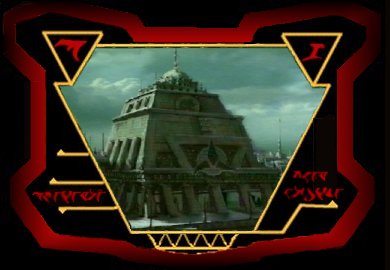

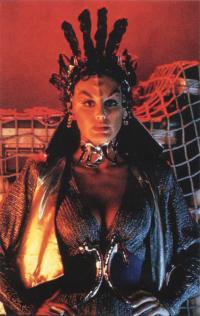 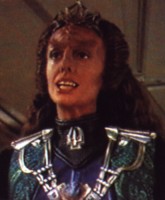 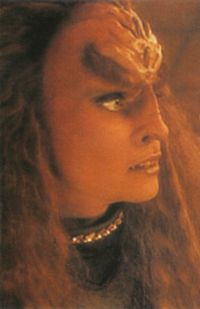 |
Homeplanet: Qo'noS
other planets:
|
||||||||||||||||||||||||||||||||||||||
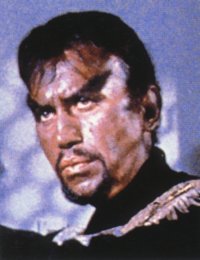
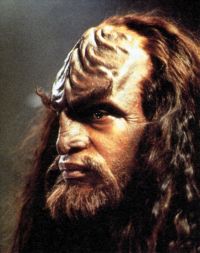
|
The klingons are a remarkable tall species. The klingon is of humanoid likeness. the form of the head varies actually extensive from the shapes of other species. Although that wasn't always the case. Sometime between the years 2289 and 2290 there must have been a drastical genetic change. Since then the skulls of the klingons have have a high wide bony forehead, the hairline lays far aback, the nose is distinctive and shows a sinuous relief. It has his contination on the forehead of the klingons. Why this has happened is only known tho the klingon people and one of the best guarded secrets. It doesn't seem to have an honorable reason as it would have been given away long time ago. Caused by the extrem seasonal fluctuation the klingons delveloped into one of the most robust species in the universe. Their body strength is far above the average of other species. One of their most distinctive feature is that they have doubled most of the vital organs. That means they have for example 2 hearts, 4 lobes of the lung and 4 kidneys. Their blood is in a complex way campatible with the blood of the romulans, which doesn't mean that they would ever donate blood for one of the Rihannsu. Klingons don't have lachrymal glands and there blood has the color of lavender. The reproduction in generall is taking place not different from other humanoid species, only that love and battle is nearly on for klingons. Klingons can get like vulkans far over 100 years, if they don't die before preferable honorfull in battle. The klingon prefers to die in battle before the aging process is taking place. | ||||||||||||||||||||||||||||||||||||||
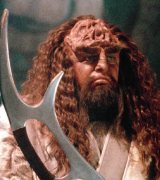
|
The history of the Klingon people is a long and glorious one. One need only listen to the epic poems and operas about the deeds of their heroes to get a feel for the richness and depth of Klingon lore. The Klingons revere their history,
or at least the history they have been taught. Klingons often prefer their cultural myths and legends to the dry (and sometimes embarrassing) details of factual history. There are many details about Klingon history that remain unknown,
obscured by the mists of time and legend, but the history we do know tells us a great deal about the Klingons as a people.
The klingon origin is described in the "The heart of fire" as followed: DKlingon legend describes the origin of their race thus: From distant Qui'Tu the gods came to Qo'noS, which burned with fire. They took the fire of Qo'noS and shaped it, forming it into a heart that beat more powerfully and more forcefully than anything in the cosmos, the heart of the first Klingon. But the beat of the first Klingon heart was a lonely one, without equal in the universe. So the gods shaped from fire a second heart, as mighty and powerful as the first. Those two hearts beat together in unison and the gods trembled at their power. The beat of the two hearts grew stronger and stronger, until the gods could not withstand their might. United together, the first Klingons slew the gods that created them, proving there was nothing two united Klingon hearts could not accomplish.
625 | the legendary fight between Kahless and Molor |
1372 | the klingons were in an industrial area, but have had no serious enemies till the Hur'q came. The invasion with superior technology lastet for 7 month and left Qo'noS devastated. They took the sword of Kahless as a token, when they left. the legends tell that the klingons drove them away.
Several hundred thousand klingons were slaughtered during this period. The klingon people needed nearly 100 years to rebuild the Empire. The saw the stars now in a different light. |
Begin of the 21st century | the klingon space programm was developed. With under lightspeed they traveled to adjoining stars and kolonised them or conquered them. They needed very long for this yourneys and the ships accommodated mostly hundrets to thousands klingons |
2069 | Begin of the 2nd Empire after the last Emperor died without a succeessor. The Chancellor of the High Council got the executive and the possition of the Emperor remained open. |
2218 | First contact of the empire with the federation, Military high command was established under the leadership of Chancelor Kadur |
2267 | Peace treaty of Organia |
between 2266 and 2268 | Foundation of the klingon-romulan alliance, Exchange of Warp-Technology and defilade-technology |
2270 | battle of Klach D'Kel Brakt with the romulans |
2285 | Attempt to steal the Genesis-weapon from the Federation,breach of the contract of Organia |
2286 | After an attack at the Betreka Nebula the klingon empire declares war against the Cardassian Unionen Krieg. For 18 years there are battles all around Betreka Nebula before the klingon Empire declares the war for won so they could pay attention for more important matters. |
2292 | Break of the alliance to the romulans, through them. Although the klingons have had at this stage already the opinion that they wouldn't need the romulans anymore. |
2293 | Explosion of the moon Praxis and the Kithomer-Conference, Begin of the reformations through Azetbur, daughter of Gorkon. the result was the strengthen of the houses and the weakening of the High Command |
2344 | romulan attack on the klingon colony Narendra III |
2346 | Kithomer-Massacre |
2352 | Narenda III Conference, Contract of an alliance with the klingon empire and the federation |
2367 | K'mpec was killed with poisson by his political enemiew. Before his death he pronounced UFP Captain Jean Luc Picard as the procecuter for his successor in the High Council.
Picard did the ritual of succession for Gowron and Duras. Worf who claimed the right of revenge killed Duras before the ending of the procedure. Duras had killed before Worf's mate K'Ehleyr.
Gowron became the only candidate for the seat in the High Council, till Duras sisters Lursa and B'Etor presented Duras son, Toral. Picard ruled that Torals claim was invalid. The house then began then a rebellion against Gowron's forces, bringing the empire into a civil war. |
2368 | Klingon Civil War |
2369 | Kahless-conspiracy |
2371-2373 | Dominion War | |
|
The Great Hall is situated in the capitol of the klingon homeworld qo'noS. It's the seat of the government of the klingon Empire, the High Council. The building can be compared with a fortress. The High Council consists of members of the highest houses in the empire. What characterists are neccessary for becoming so importanft to get a seat in the High council is not known.
the aggressive klingon cultur, made them to a strong, respected and feared Military nation, which is knwon to be mostly hostile against other species.
political relations to the Federation: In the year 2218 they made first contact. It ended in a catastrophy and both became grimly enemies. The contract of Khitomer brought finally peace with the federation. Relation to neighbour systems and - species: Only unwillingly the alliances with other species and teretorial neighbourly Races were agreed to. They live for a glourious fight and are a bit frustrated cause of the limited possibilites of conquering new terretories in the alpha quadrant. Frequent they turn against other species just for the sake of the fighting. In time of peace the klingons have alot of relations to other species, which they more tolerate than respect. An good example is the Ferengi aliance. The klingons think of the ferengies as spineless, greedy creatures without any honor. |
|||||||||||||||||||||||||||||||||||||||
The Imperial Klingon judiciary is based on the principal assumption that the accused is guilty until proven otherwise. Klingon court cases are judged by a single judge. The judges are appointed by the High Council, serving for 7 years at which time they may have their term renewed or replaced by the High Council. The defendant may represent himself or choose the option of having a separate legal representative. In times of emergency, barring objection by more then 1 member of the High Council, this procedure may be abbreviated in the interests of the survival of the Empire. The Imperial Courts don't decide guilt or innocence based on just the facts of the crime, but also by the conduct of the accused and the status of the family. A certain procedure is to be followed after the commission of a crime in the Klingon Empire.
Mek'ba: In the Klingon system of justice, the portion of a trial or appeal in which evidence was heard. The Mek'ba had strict rules for the presentation of evidence and for the conduct of both the accuser and the accused. |
|||||||||||||||||||||||||||||||||||||||
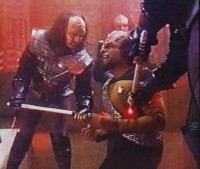
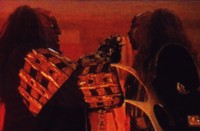
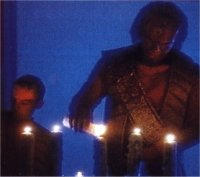
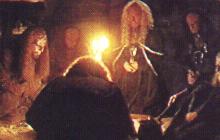
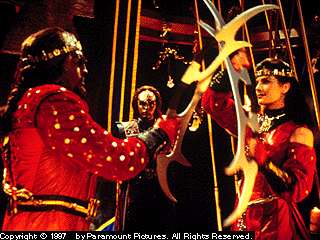
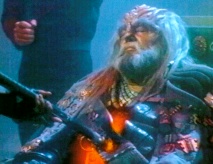
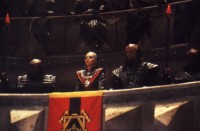
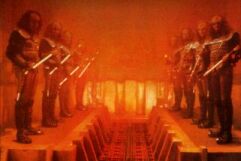
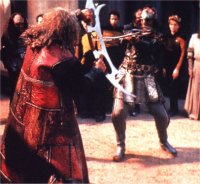
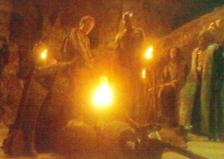
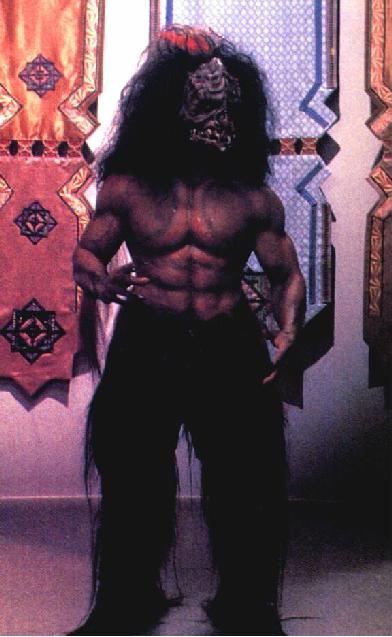 |
In general are the klingons a emotional and short-tempered species with a notion for battles and fights.
Their device is like: One for all and all for one. If you are inside a klingon companionship you can be sure of unrestrained loyality. Only if you have a higher rank it is a bit more difficult.
klingons of a higher rank always have to be aware of the danger their live could be in. On possiblity to rise in military is to kill your superior in a fair battle.
Traditions/Rituals:
Religion: Klingon legend describes the origin of their race thus: From distant Qui'Tu the gods came to Qo'noS, which burned with fire. They took the fire of Qo'noS and shaped it, forming it into a heart that beat more powerfully and more forcefully than anything in the cosmos, the heart of the first Klingon. But the beat of the first Klingon heart was a lonely one, without equal in the universe. So the gods shaped from fire a second heart, as mighty and powerful as the first. Those two hearts beat together in unison and the gods trembled at their power. The beat of the two hearts grew stronger and stronger, until the gods could not withstand their might. United together, the first Klingons Kortar and his mate slew the gods that created them, proving there was nothing two united Klingon hearts could not accomplish. Klingons value honor above all else. Those who die honorably are said to join the spirit of Kahless in Sto-Vo-Kor. Dishonorable deaths hold the destiny of the underworld of Gre'Thor, guarded by Fek'lhr. Gre'thor is reached by passage on the Barge of the Dead, eternally piloted by Kortar, over the River of Blood. The dead are not mourned, but celebrated, and the body is viewed as an empty shell to be disposed of. There is the belief that the afterlife will be one constant battle. Kahless is a historical figure, who united the Klingon Empire about 15 centuries ago. The story of Kahless, his achievements and his death is a major cornerstone of the Klingon mythology and religion. Klingon honor is based upon the way Kahless lived his life, and Klingon's strive to die in battle as Kahless did, fighting with honor. To die any other way, even after a long life of honorable and victorious battles is a disgrace. Sto-Vo-Kor is a mythological place for the afterlife for the honored dead. It is very much like Valhalla for the Vikings. When a Klingon dies honorably they are taken to Sto-Vo-Kor where they reside with Kahless to fight battles in the after life as they did in life. Gre'thor is the place in Klingon mythology where the dishonored go to die. The mythic Klingon beast, Fek'lhr is the guardian of Gre'thor. Gre'thor can be compared with the Norse Feneris. |
||||||||||||||||||||||||||||||||||||||
| Weapons/Defence-/Ships-: Weapons: |
|||||||||||||||||||||||||||||||||||||||
|
here some more Links: german english
for more information email me Thanks to the Registraturkommandantur (RKOM) and the Ex Astris Scientia for pictures and informations. | |||||||||||||||||||||||||||||||||||||||
 STAR TREKTM and many related terms are registered trademarks of Paramount Pictures, Inc. This site is a strictly non-commercial site. No copyright infringement intended. In case of objections, please use the subcommunication © leupi 1997-2004. All rights reserved. | |||||||||||||||||||||||||||||||||||||||